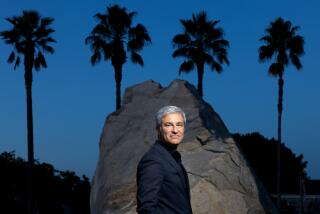Broad museum plan for downtown L.A. gets mixed reviews
- Share via
When should officials give a billionaire a 99-year lease on city-owned land worth millions in downtown L.A. for $1 a year?
In the high-stakes game to land a grand art museum proposed by Eli Broad — the developer, philanthropist and political force — such enticements mark the going rate.
Broad has spent several years pursuing a Westside location for a museum to house his coveted 2,000-piece contemporary art collection. In recent weeks, however, downtown Los Angeles has emerged as a leading contender, competing with a lot in the Santa Monica Civic Center.
In return for the $1-a-year lease, Broad would pay for the museum’s construction and fund a $200-million endowment to pay the facility’s operating costs.
Downtown boosters say a Broad museum could kick-start the stalled $3-billion Grand Avenue project, although Broad himself acknowledges that the museum alone would probably not be enough to move the project forward immediately. The mega-development, which would include residential towers, a five-star hotel and upscale stores on land now owned by the city and county of Los Angeles, has been on hold because of the recession.
Critics of the museum plan scorn it as an unreasonable giveaway. They include at least one prominent elected official, L.A. County Supervisor Michael Antonovich, a longtime critic of the Grand Avenue project. He has questioned whether cutting such a deal with Broad makes sense.
“We’re concerned about whether the taxpayers are getting the best deal that they could get for arguably the most valuable real estate in downtown L.A.,” said Paul Novak, Antonovich’s planning deputy.
Novak said the deal could mean less land for retail businesses at the project, in effect reducing sales tax revenue going to local government. The criticism echoes the objections that Antonovich and others have already raised about the tax subsidies the Grand Avenue project depends on.
In an interview Thursday, Broad defended the museum plan. “It just burns me that people are saying they’re giving me, a billionaire, $1 a year for nothing,” he said, “without looking at the public benefit that’s being created, without thinking of all these children that are going to go there free of charge and all of the other benefits.
“Getting criticized for doing that blows my imagination, frankly,” he said, adding that other local museums have identical lease agreements. “Any city in America would like to get a museum built if they didn’t have to pay for it.”
Broad said he had considered and dismissed Grand Avenue for his museum after early discussions with the developer went nowhere in 2007. Then late last year, he said, Mayor Antonio Villaraigosa asked him to reconsider.
“I said, ‘Antonio, doing business downtown with the city ... and the county is not my idea of fun.’ He encouraged me to do it,” Broad said.
He said the city is asking him to finance a $20-million, 300-space parking garage near the museum, a request Broad said he would be happy to see eliminated. He would be paid back for two-thirds of the cost, city officials said.
The 76-year-old philanthropist is known for driving hard bargains.
Two weeks ago, Beverly Hills officials pulled out of negotiations over the museum. In a letter to Broad, City Manager Jeffrey Kolin said they withdrew because “we understand the Broad Art Foundation is now pursuing another location.”
Broad said Thursday that the city had offered to invest $50 million to $60 million to purchase about an acre for the museum and then lease it to him for $1 year for 99 years. Beverly Hills officials declined to comment about their offer, saying it was discussed privately.
Last month, Santa Monica offered Broad a 2.5-acre plot of city-owned land next to the Santa Monica Civic Auditorium at a lease of $1 a year for 99 years, and offered to pay $1 million for the museum’s design.
In a staff report, City Manager Rod Gould strongly backed the project, saying it would be “designed by a world-class architect and would constitute a destination in and of itself.”
Bobby Shriver was the only member of the City Council to oppose the offer, saying he would like to see the city have a greater say in the makeup of the museum board and more discussion on whether artwork from Broad’s collection could be sold in the future to keep the collection fresh and relevant.
It’s “a great opportunity, but the deal isn’t right yet,” Shriver told The Times in March.
In many ways, Grand Avenue — a project Broad has called a Champs-Elysees for downtown — seems an obvious home for his art collection.
Late last year, he resigned from the Grand Avenue Committee, a group of citizens acting under the direction of a joint city-county authority to oversee the development.
He quit to avoid conflicts of interest as private negotiations to bring the museum downtown began, officials told The Times in January.
City Councilwoman Jan Perry said that if an agreement can be reached with Broad, a deal will be presented to the joint city-county authority that oversees the Grand Avenue project and vetted in public.
Robert Stern, president of the Center for Governmental Studies, said that although including a museum seems to make sense for the project, “it’s always difficult to give away something that has value.”
Transparency is crucial, so “everyone knows what’s happening and what the consequences will be,” Stern said. “They really should spell it out to everybody, and make sure the benefits are really there and make sure it really happens.”
If built on the southwest corner of Grand Avenue and 2nd Street, Broad’s museum would be across the street from both Walt Disney Concert Hall and the Museum of Contemporary Art, as well as a short walk from the Cathedral of Our Lady of the Angels.
“I think the Broad museum would have a huge halo impact on all of downtown,” said Jack Kyser, an economist for the Los Angeles County Economic Development Corp. “For somebody who is into culture, this would be the promised land.”
For his part, Broad said his mind is not yet made up. Santa Monica, he said, remains a strong candidate.
“They’re ready to go should we choose them,” Broad said.
Times staff writers Mike Boehm and Phil Willon contributed to this report.
More to Read
The biggest entertainment stories
Get our big stories about Hollywood, film, television, music, arts, culture and more right in your inbox as soon as they publish.
You may occasionally receive promotional content from the Los Angeles Times.











